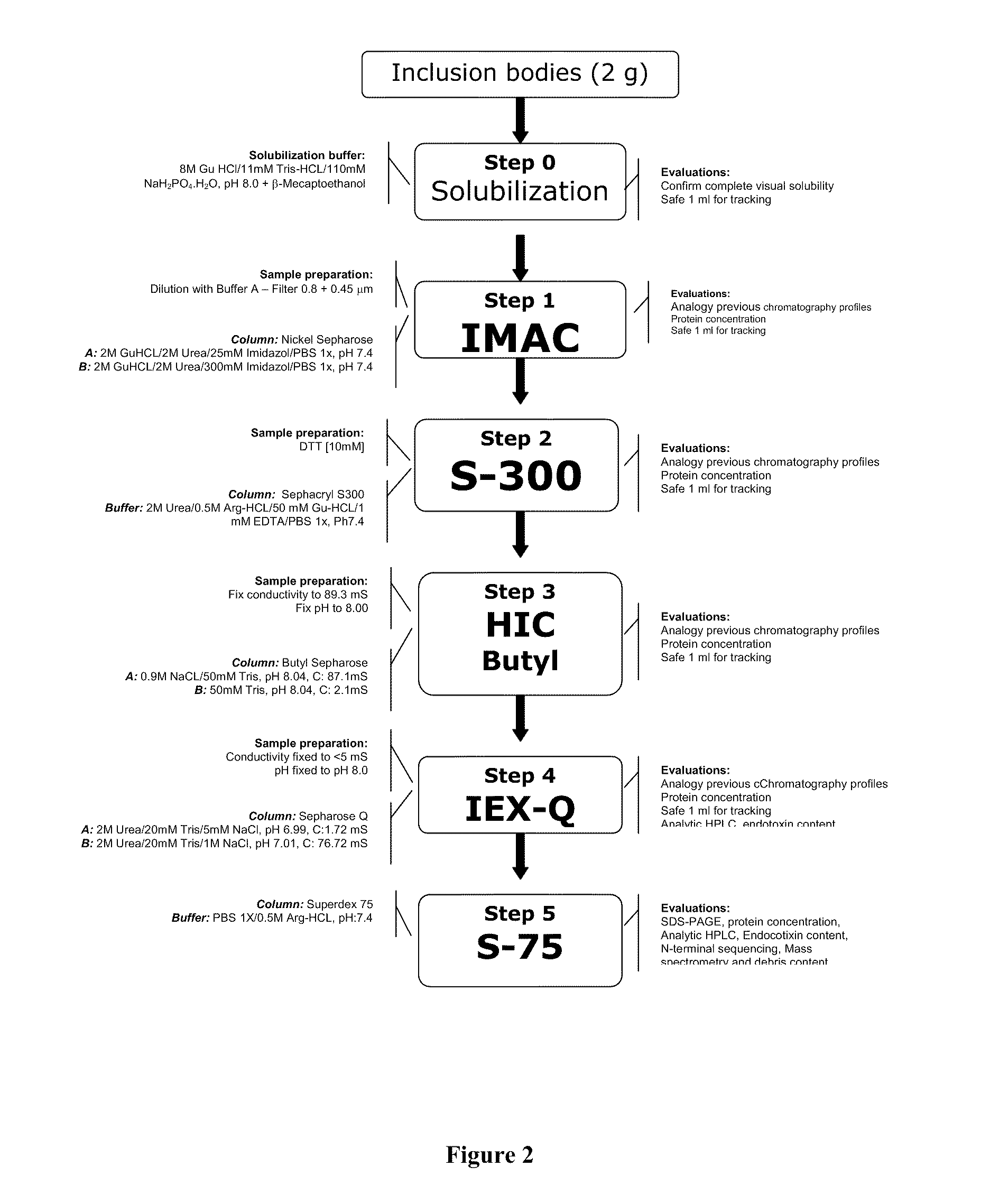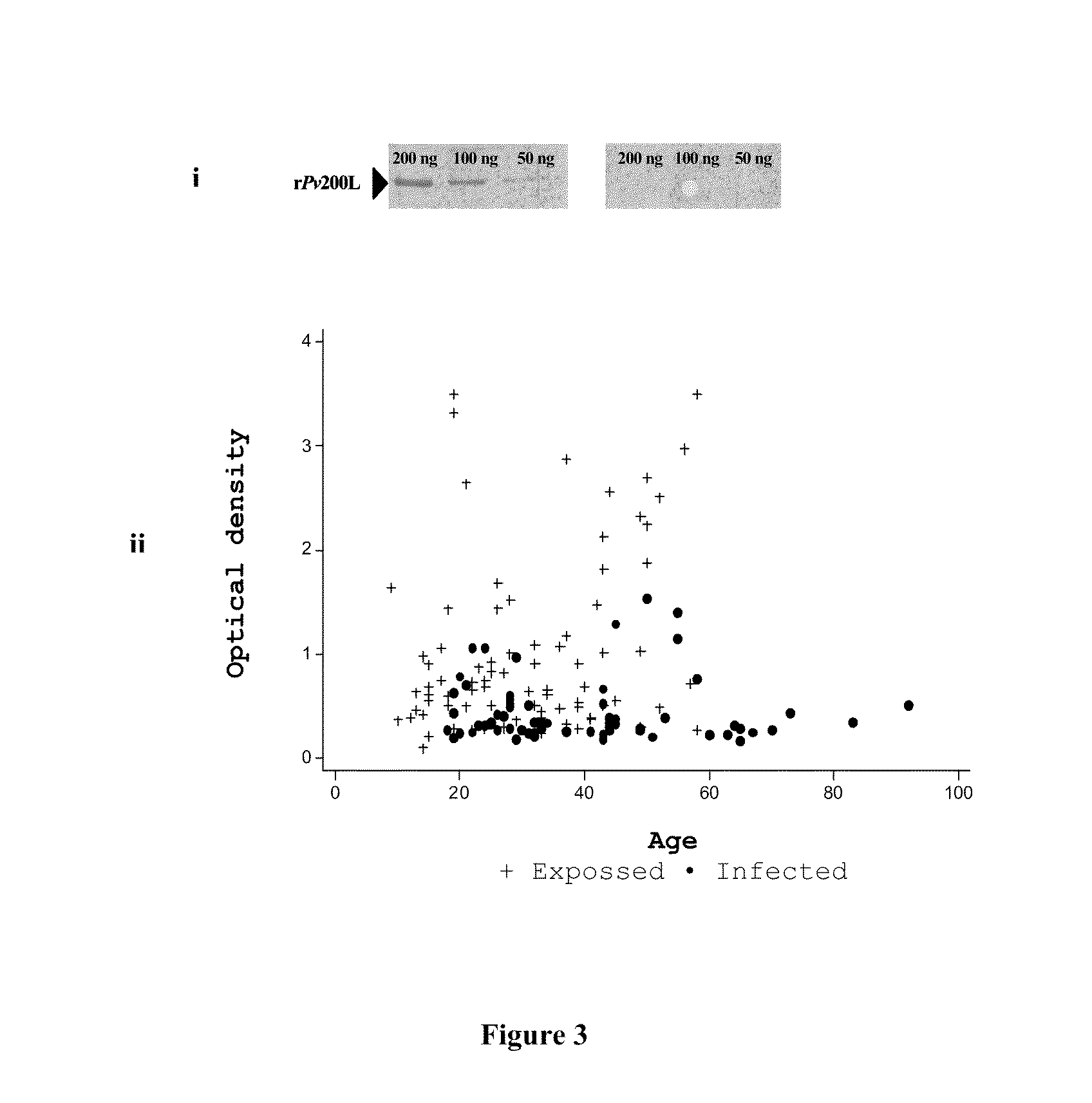Vaccine against malaria, based on the 200l subuniti of plasmodium vivax msp1 protein
a technology of plasmodium vivax and msp1 protein, which is applied in the field of vaccines against malaria, can solve the problems of high risk of tourist and traveler infected, increased complexity, and excessive cost of control management and treatment of malaria
- Summary
- Abstract
- Description
- Claims
- Application Information
AI Technical Summary
Problems solved by technology
Method used
Image
Examples
example 1
Production Systems of Pv200L as a Recombinant Protein
[0098]The Pv200L subunit has been produced as a recombinant protein. During the development process of invention two recombinant prototypes were obtained, rPv200L and EcPv200L. The rPv200L was obtained from a PCR amplified product, that was inserted into a plasmidic vector pRSET-B, which was subsequently cloned in a BL21(DE3)-RIL E. coli bacteria. The rPv200L purification was achieved by a step wise process throughout a manual Nickel column chromatography (IMAC), process facilitated by the addition of histidines toward the N-terminal extreme.
[0099]The product obtained can be observed in FIG. 1, in which is shown: (i) acrilamide gel electrophoresis stained with Coomassie Blue of the rPv200L at 10, 1 and 0.5 μg. (ii) chromatographic profile by reverse phase HPLC demonstrating more than 90% of homogeneity in the final product.
[0100]Due to promissory results obtained with this unit, we decided to establish and improve the production s...
example 2
Seroepidemiology Assays of Pv200L Subunit
[0104]The Pv200L subunit is highly recognized by subjects of endemic areas who have been infected and / or exposed to P. vivax infection. FIG. 3 shows IgG antibodies levels against rPv200L found during a seroepidemiologycal study carried out in the colombian Pacific Coast.
[0105]Sera from P. vivax-infected individuals recognized specifically the rPv200L recombinant protein by immunoblot (FIG. 3i, left), while control subjects, who have never visited or been exposed in endemic areas, do not recognize the rPv200L (FIG. 3i, right). Distribution of optical density values according to age (FIG. 3i) shows that there is a tendency to develop higher antibody titers at 2 and 5 decade of life, this phenomenon is more remarkable among exposed (•) than infected individuals (+).
TABLE 2Seroepidemiology of Pv200LPositive % IgG(IC exactoOD AverageAntibodiesGroupη95%)(IC 95%)titersInfected8172.81.015103-105(61.8-82.1)(0.828-1.203)Exposed6952.20.464102-104(39.8-6...
example 3
Immunogenicity of rPv200L in BALB / c Mice
[0108]BALB / c mice were immunized with 50 μg of the rPv200L under a regimen of three intraperitoneally immunizations. Levels of specific IgG antibodies against rPv200L after the third immunization of the protein emulsified in Freund adjuvant is shown in
[0109]FIG. 4. After last immunization, antibody titer of IgG type anti-rPv200L reach levels over 1×107 dilutions (FIG. 4i). Such antibodies are capable to recognize the immunogen rPv200L (4ii, left) and its P. falciparum homologous rPf190L (4ii, right). Finally, antibodies induced by immunization with rPv200L in BALB / c mice were able to recognize the native protein on P. vivax schizont (400iii).
PUM
| Property | Measurement | Unit |
|---|---|---|
| width | aaaaa | aaaaa |
| adhesion | aaaaa | aaaaa |
| affinity chromatography | aaaaa | aaaaa |
Abstract
Description
Claims
Application Information
 Login to View More
Login to View More - R&D
- Intellectual Property
- Life Sciences
- Materials
- Tech Scout
- Unparalleled Data Quality
- Higher Quality Content
- 60% Fewer Hallucinations
Browse by: Latest US Patents, China's latest patents, Technical Efficacy Thesaurus, Application Domain, Technology Topic, Popular Technical Reports.
© 2025 PatSnap. All rights reserved.Legal|Privacy policy|Modern Slavery Act Transparency Statement|Sitemap|About US| Contact US: help@patsnap.com



